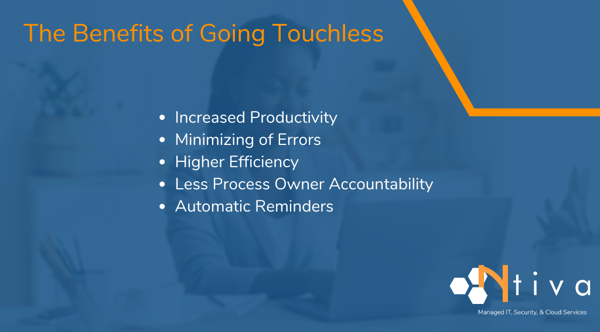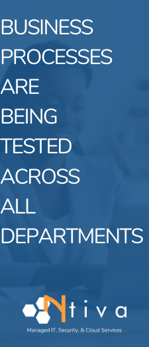The COVID-19 pandemic has put office systems and processes to the test. With more than 16 million office workers transitioning to remote work over the past 5 months, tens of thousands of businesses are trying to stay productive while their employees can no longer connect physically with each other daily in a central workplace.
For a long time now, technology has offered the promise of a paperless office — removing those stacks of papers on everyone’s desktops that need to be mailed from office to office. Still, many offices are far from paperless (one source says the average American worker prints 34 pages a day).
With so many businesses going remote — and many realizing that working increasingly remotely is now the future state regardless of the arc of COVID-19 — departments that are feeling the crunch and having their processes tested include accounting (purchase orders, accounts receivable), HR (employee documentation, onboarding forms), sales (proposals, bid management, contracts, reports, etc.) to name three of many.
Indeed, offices that are not fully paperless are at a disadvantage. But the paperless office is now only a single step on a longer journey toward efficiency and increased productivity.
A Touchless Process

The truth is, normal businesses have a lot of redundancy. Different departments often have different processes and work in separate systems, and this can lead to problems, such as:
Duplication of efforts — often, the exact same information lives in multiple systems, creating redundancy and more work for everyone
Errors — Frequently, people are converting data mediums, changing from paper to digital and sometimes digital to another digital system. The fact that multiple people are entering information into these systems often results in errors and discrepancies. When these are caught, they take valuable employee time to fix; when they’re not caught and go out into the world, they can make a business look unprofessional, or worse, lead to direct losses such as those stemming from billing discrepancies.
Slowness — all of this inefficiency ultimately slows things down. Businesses don’t always notice this because they’re used to their existing processes, but they also don’t know how much faster things would go with a more efficient solution. Also, a slow business process could cost more to run and makes it harder for someone to do business with that company.
Idiosyncratic workflows make employees hard to replace — too often, businesses have processes that “get the job done” but are not very straightforward or efficient. It’s possible that only one or two employees will know the process and its critical dependencies, and this leads to two problems: bottlenecks, and the difficulty in replacing one of these key employees should the need arise.
>> Touchless process is a business concept for a workflow that minimizes friction and seamlessly links all parts of a business together. More accurately, it can be thought of as a “one-touch” process, in that information is entered once, and then becomes available through the rest of a business’s systems. We achieve this by linking existing systems or by building a comprehensive solution from scratch.
A touchless process isn’t a one-and-done thing, but rather a spectrum — businesses can be more or less touchless in their operations, and because companies change all the time, they can continually strive to be more touchless.
The Benefits of Going Touchless

The touchless process has a number of benefits, including:
Increased productivity — think about how well your business would run if all your systems were integrated and you never had to enter any piece of information more than once. Instead, the information would be at your fingertips at all times.
Minimizing of errors — when processes are automated, you’ll see a dramatic decrease in the number of errors. We sometimes refer to this as “bumper bowling,” because you’ve smoothed out the process and made it that much easier to avoid errors — like bowling with bumpers in place, the touchless systems direct customers and employees toward the right outcome, every time.
More speed means more business — all of these increases in efficiency mean that you’ll be able to operate faster — from bidding on projects faster, to contacting customers faster, to generating invoices faster and paying your own contracts faster. Simply put, you can get more business done in the same amount of time.
Less fear about losing process owners — when you have a system in place that works seamlessly, you no longer need to panic when a key employee is sick for the day, or lets you know with a week’s notice that he or she is moving across the country.
Automatic reminders when something is late — you may be surprised to find out how much of business operations is reminding people when they’re late on delivering something. A touchless process can build in automatic reminders, so that employees no longer have to spend their valuable time checking and reminding others of what they are owed.
The Touchless Process in Action
Here’s an example of how a touchless process might work in practice, as distinguished by a more traditional process. Manual processes are highlighted in red, while automated processes are in green.
Current Process - includes much redundant data entry and moving of information to different systems such as excel sheets, estimation software, PDFs, and accounting software.
- The customer sends a bid invitation via email
- PM prints documents and sends to estimate dept via interoffice mail
- PM manually inputs bid data into multiple excel trackers
- Estimator manually inputs bid data into estimation software
- Estimate approved
- Estimator manually fills out pdf form with final bid data
- Accountant manually inputs final bid data into accounting software for invoicing
Touchless Process - note that we only have one red line of manual uploading to the bid management portal, after which the touchless process takes over
- Bid invitation sent via email
- PM logs in to the Bid Management Portal
- PM uploads related documents and manually inputs bid data via webform
- System adds the bid to a digital list of active bids
- System automatically sends bid data to the estimation software
- System automatically notifies estimator
- Estimate sent and approved
- Estimator logs in to the Bid Management Portal and marks bid approved
- System automatically imports final bid data from estimation software
- System automatically sends bid info into the accounting software for invoicing
- System automatically notifies accountant
- System automatically removes bid from active bids list
- Historical data and documents stored digitally in database
As you can see, simply by reviewing the red/green color codes above, a well-designed touchless process can eliminate nearly all but the initial human touch points (aka: data entry) creating a seamless process with automation, alerts and tracked approvals.
Next Steps: Determine if a Touchless Process is for You
Once you decide that you may be ready to move forward with a more touchless process for your business, there are a few things to ask yourself:
- What you are solving for—what would your best case look like? Is there a way you wish your business operated that we can use as a jumping-off point? What could the future state look like if you had a magic wand to solve any bottlenecks and have systems talk perfectly?
Next, it’s time to whiteboard (map out) your existing process and all touch-points. For example, take a single purchase order at your company and track every person and system it interacts with. Then, take that exercise and do it for every other kind of document you regularly work with.
This will help you figure out who touches things and identify the places errors and bottlenecks occur. For example, you can figure out the many precise steps that need to happen and who at your business needs to handle them.
Other important questions to consider include:
- What’s the potential Return on Investment (ROI) of overhauling your process? This might include cost savings and risk mitigation, as well new revenue you could make by getting more business done in the same amount of time. There are also non-monetary rewards, such as appearing more professional and having higher customer satisfaction.
One other thing to consider is that your process is part of your company’s intellectual property. As such, having a custom touchless process makes your company more valuable (as well as more attractive to investors and buyers, if you’d ever consider selling down the road).
- How much time will a touchless process save your company? You can determine the hours and the hourly rates of the people who touch the process. When figuring this out, don’t forget to consider the time each process takes from start to finish, and the hours/days you can cut between customer interactions and approvals, invoicing, payments, etc.
- Is your company growing and will a touchless process help you scale faster? If your business has hit a plateau, a touchless process is exactly the kind of efficiency that can help you scale it to the next level.
- What business risks could you eliminate? As evidenced by the current situation, the list of risks you could protect your business from may be longer than what first comes to mind.
The Time to Consider a Touchless Process is Now
 The COVID-19 pandemic is not just a temporary setback—with talk of the disease returning seasonally, it might be our new reality. But the existence of the COVID-19 pandemic only highlights something that should have been obvious all along.
The COVID-19 pandemic is not just a temporary setback—with talk of the disease returning seasonally, it might be our new reality. But the existence of the COVID-19 pandemic only highlights something that should have been obvious all along.
A touchless process makes sense even in the best of times—why go back to the past? Improving your process and efficiency are things that all businesses should be evaluating as part of routine self care.
One other thing to consider is that your process is part of your company’s intellectual property. As such, having a custom touchless process makes your company more valuable (as well as more attractive to investors and buyers, if you’d ever consider selling down the road).
Through this process, keep in mind that you can decide on the scope of the project—how touchless you want to become—based on your budget. Often the right AppDev partner will first identify off-the-shelf (OTS) solutions or process steps that get you most of the way there without less (or no) custom development.
We're Here to Help
Sign up for a free 30-minute “Discovery” discussion to explore your hoped-for touchless process, potential ROI, and how others in Ntiva’s customer base have benefited from streamlining their operations!
.png?width=580&name=Touchless%20HERO(1).png)



